While they’re useful cartridges in certain situations, there are different pros and cons associated with using the .223 Remington/5.56x45mm NATO and the 7.62x39mm. Here’s what you need to know about the 5.56 vs 7.62x39mm debate.
Fighters armed with the 5.56x45mm NATO and the 7.62x39mm have engaged in furious combat all over the world ever since military forces using those cartridges first met in the jungles of Vietnam during the 1960s. The 5.56 vs 7.62x39mm debate kicked off shortly thereafter and has never really ended as shooters continue to intensely argue the strengths and weaknesses of each cartridge in sporting goods shops, gun magazines, online forums, and shooting ranges across the country.
Many shooters and hunters probably agree that the 5.56x45mm NATO and 7.62×39 are both effective cartridges for accomplishing specific tasks. However, the 5.56 vs 7.62x39mm debate can be particularly difficult to navigate due to the large number of misconceptions and myths that abound regarding the cartridges.
In this article, I’m going to do my best to sort through the 223/5.56 vs 7.62x39mm debate in an even handed manner in order to help you make an informed decision on which one is right for you.
Table of Contents
Before we get started, I have two administrative notes:
First, though the .223 Remington and the 5.56x45mm NATO are technically different cartridges, the practical difference in performance between the .223 vs 5.56 is very small and doesn’t make any difference for the purposes of this article. Use extreme caution when attempting to interchange the .223 Remington with its NATO cousins though.
For a more detailed discussion on the differences between the .223 Remington and 5.56x45mm NATO cartridges, read this article:
5.56x45mm NATO vs .223 Remington
Second, some of the links below are affiliate links. This means I will earn a small commission (at no extra cost to you) if you make a purchase. This helps support the blog and allows me to continue to create free content that’s useful to hunters like yourself. Thanks for your support.
Now that we’ve gotten that out of the way, let’s get started.
5.56 vs 7.62x39mm: History
The major powers equipped most of their troops with rifles chambered in full-power cartridges like the .30-06 Springfield, 7.62x54mmR, .303 British, and 7.92x57mm Mauser at the beginning of World War II. While those rifle cartridges were quite powerful and had a relatively long effective range, they also produced a lot of recoil and were challenging to handle in a fully automatic rifle. They also tended to be long, cumbersome, and unwieldy when used for close quarters fighting.
Recognizing the shortcomings of their primary infantry rifles, the various armies supplemented those rifles with sub-machine guns chambered in pistol cartridges. For instance, the American Army utilized the Thompson and M3 sub-machineguns chambered in .45 ACP, the Germans equipped some of their Soldiers with the MP-40 chambered in 9mm Luger, and the Soviets used PPSh chambered in 7.62x25mm Tokarev. Those sub-machineguns were very effective at close range and were much easier to control during fully automatic fire, but they didn’t have nearly as much stopping power or as long of an effective range as full-powered rifle cartridges.
Since typical combat ranges were typically between 100 and 300 yards, military leaders recognized the need for an intermediate power cartridge to fill the gap between pistol cartridges and full-powered rifle cartridges. In short, they wanted an intermediate cartridge with more power and a longer effective range than a pistol cartridge, but without the power and recoil of a full-powered rifle cartridge.
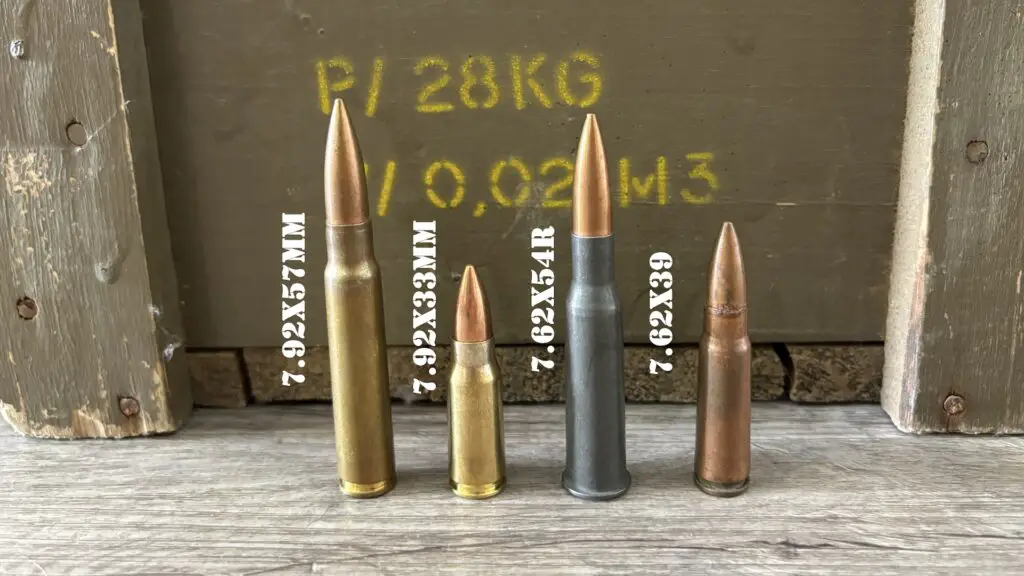
The Germans developed the StG 44 rifle and the accompanying 7.92x33mm Kurtz cartridge during World War II to fulfill that gap in capability. The Germans introduced the new weapon and cartridge too late in the war and in numbers too small to change the final outcome of WWII. However, the performance of the StG 44 and 7.92x33mm Kurtz impressed the Soviets so much that they decided to develop a similar rifle and cartridge.
The resulting 7.62x39mm (M43) cartridge fired a .311″ 123 grain boat tail full metal jacket (FMJ) bullet at a muzzle velocity of 2,300 feet per second (1,445 foot pounds of energy). Over the years, the cartridge has sometimes been referred to as the 7.62 Soviet, the 7.62 Short, the 7.62 Warsaw Pact, and the .30 Russian Short.
Featuring a rimless and highly tapered case to assist with reliable feeding and extraction, the cartridge was a big hit with the Soviet Army from the start. The Soviets adopted a number of different weapons chambered in 7.62x39mm like the semi-auto SKS rifle, the RPD machine gun, and the famous AK-47 assault rifle (and AK derivatives like the AKM) over the ensuing years.
During that same time, the US Military went through a similar process in searching for a replacement for the .30-06 Springfield and the M-1 Garand rifle. Though they initially decided upon the M-14 battle rifle and the 7.62x51mm NATO cartridge as initial replacements, many in the military weren’t pleased with the M-14 either. In short, those people though the M-14 was still too heavy and difficult to control when firing in full automatic mode.
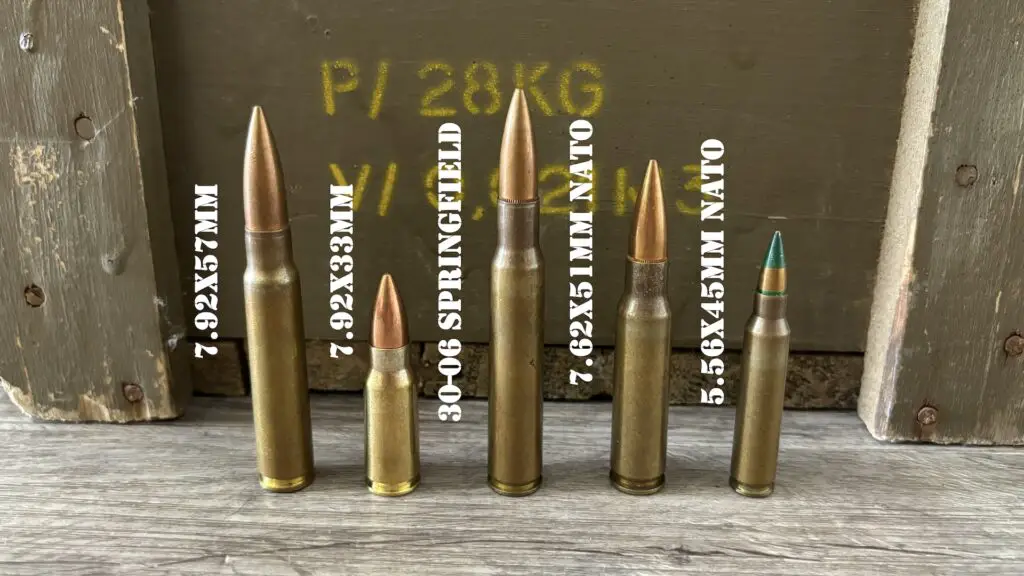
For those reasons, the US Army, Air Force, and Marine Corps transitioned over to the lighter weight M-16 rifle and the high velocity 5.56x45mm cartridge in the 1960s.
If you’d like read a more detailed discussion on the reasons the United States made that switch as well learn about the differences between the .223 Remington and .308 Winchester cartridges, read this article:
.223 vs 308: Which Is Better For You?
Derived from the .223 Remington (also known as the .223 Rem), the original M193 ball load for the 5.56x45mm NATO fired a .224″ 55 grain full metal jacket bullet at 3,250 feet per second (1,290 foot pounds of energy). Well received at first, the M-16 rifle and the 5.56x45mm cartridge saw extensive action during the Vietnam War. Unfortunately, both the rifle and cartridge suffered through major teething problems during that conflict.
However, modifications to the rifle and the propellant used in the cartridge solved many of those issues and both remain in common use all over the world, to include the armed forces of the NATO countries. Additionally, the military adopted a the M16A2 with a faster rifling twist rate (1:7 vs 1:12) and a new 5.56x45mm NATO ball load during the 1980s. Incorporating a new bullet design with a steel penetrator, the M855 load fired a 62 grain full metal jacket bullet at 3,025 feet per second (1,260 ft-lbs of energy). The M855 is often referred to as “green tip ammo” because of the green paint on the bullet.
The M855 penetrates much better than the M193, but complaints about the terminal performance of the bullet from Soldiers eventually spurred the development of another ball load during the 2000s.
The resulting M855A1 load uses a lead free 62 grain bullet made from copper alloy with a steel penetrator. It’s loaded to a higher pressure than the M855 load and is designed for optimum performance out of the short barreled M-4 carbines commonly used by the military these days. All things considered, the M855A1 has been well received and has a reputation for being more accurate, penetrating barriers more effectively, and having better terminal performance than the old M193 and M855 ball ammunition.
Since the M855A1 uses a lead free bullet, it’s also more environmentally friendly than traditional ammunition. References to the M855A1 as “green ammo” sometimes results in confusion with the “green tip” M855. Currently, the US military uses both the M855 and M855A1, but the Army in particular favors the M855A1 for overseas deployments.
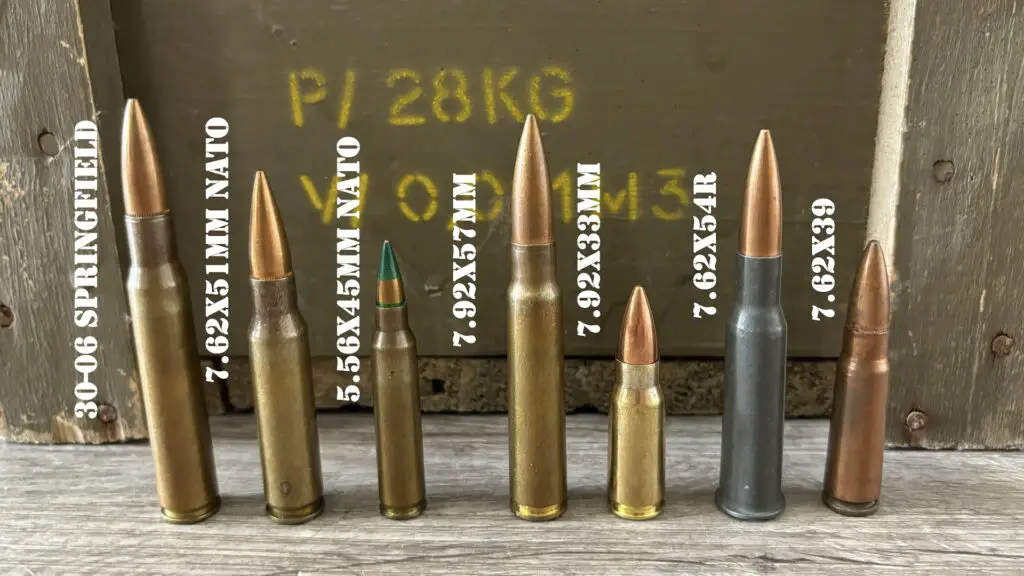
5.56 vs 7.62x39mm: Cartridge Sizes
You can see the differences between the 5.56mm NATO and 7.62x39mm cartridges in the photo below
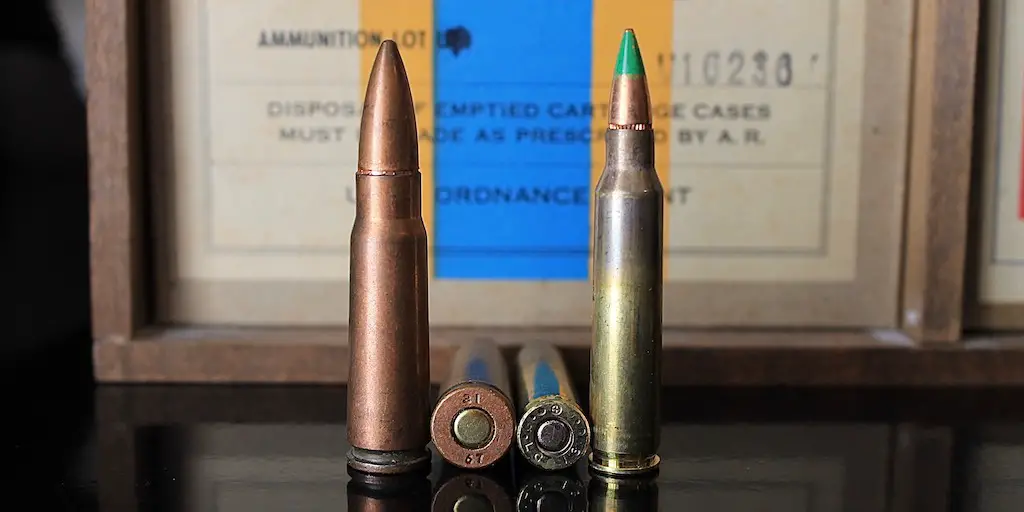
The 5.56x45mm cartridge has a slightly longer case length (1.76″ vs 1.528″) and overall length (2.26″ vs 2.2″). However, the 7.62x39mm cartridge has a larger rim diameter (.447″ vs .378″) and uses larger diameter bullets (.310″ vs .224″).That being said, the larger rim diameter of the 7.62x39mm is offset somewhat by the longer and less tapered case of the 5.56x45mm NATO. For that reason, two cartridges have almost the same case capacity.
Note: while the case capacity figures listed below do give a good indication of the differences between the two cartridges, exact case capacities vary slightly according to the brand of brass used. Also, the 5.56x45mm NATO is not a SAAMI cartridge, so the maximum listed pressure below is for the .223 Remington.
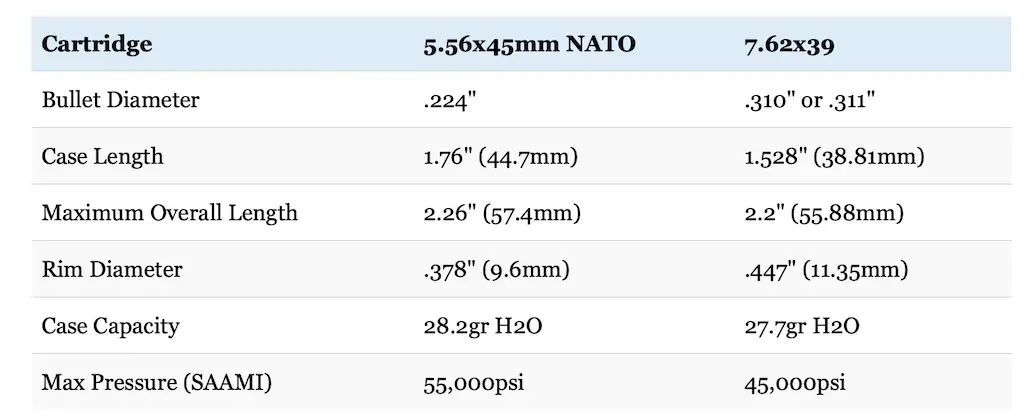
7.62×39 vs 5.56 Ballistics
The table below compares 55gr Hornady Frontier M193 (.243 BC), 62gr Barnes TSX BT (.287 BC), and 77gr TMK (.420 BC) loads in 223 Remington and 5.56x45mm NATO to a 123gr Hornady SST (.295 BC) load in 7.62x39mm.
This data is for Hornady, Barnes, and Black Hills factory ammo and a 200 yard zero.
| Cartridge | Muzzle Velocity Energy | 100 Yards Trajectory Energy | 200 Yards Trajectory Energy | 300 Yards Trajectory Energy | 400 Yards Trajectory Energy | 500 Yards Trajectory Energy |
|---|---|---|---|---|---|---|
| 5.56mm 55gr | 3,240fps 1,282ft-lb | +1.4″ 983ft-lb | 0″ 744ft-lb | -7.2″ 553ft-lb | -22.1″ 403ft-lb | -47.7″ 290ft-lb |
| 5.56mm 62gr | 3,000fps 1,239ft-lb | +1.7″ 984ft-lb | 0″ 773ft-lb | -7.9″ 599ft-lb | -23.9″ 458ft-lb | -50.4″ 346ft-lb |
| 5.56mm 77gr | 2,750fps 1,293ft-lb | +2.0″ 1,100ft-lb | 0″ 931ft-lb | -8.3″ 783ft-lb | -24.3″ 654ft-lb | -49.4″ 542ft-lb |
| 7.62×39 123gr | 2,350fps 1,508ft-lb | +3.3″ 1,176ft-lb | 0″ 905ft-lb | -13.9″ 690ft-lb | -41.6″ 524ft-lb | -87.5″ 405ft-lb |
As you can see, all of the 223 Remington 5.56x45mm loads have a significantly higher velocity and much flatter trajectory than the 7.62×39.
However, since it uses a significantly heavier bullet, the 7.62×39 has about 20% muzzle energy than all the 5.56mm NATO loads.
Due to their much higher starting velocity, the three 5.56x45mm NATO loads remain supersonic out to a much longer range the 7.62x39mm. While the 7.62x39mm load slows to below the speed of sound around 575 yards, the 55gr, 62gr, and 77gr 223 Remington and 5.56x45mm NATO loads remain supersonic out to around 725, 750, and 1,000 rounds respectively.
The chart below compares how much a 10 mile per hour crosswind impacts those same four loads out to 500 yards.
| Cartridge | 100 Yards Wind Drift | 200 Yards Wind Drift | 300 Yards Wind Drift | 400 Yards Wind Drift | 500 Yards Wind Drift |
|---|---|---|---|---|---|
| 5.56mm 55gr | 1.2″ | 4.8″ | 11.6″ | 22.1″ | 37.4″ |
| 5.56mm 62gr | 1.1″ | 4.5″ | 10.6″ | 20.0″ | 33.5″ |
| 5.56mm 77gr | .8″ | 3.3″ | 7.8″ | 14.4″ | 23.5″ |
| 7.62×39 123gr | 1.5″ | 6.2″ | 14.8″ | 27.9″ | 46.2″ |
While the 7.62x39mm uses a much heavier bullet that has a higher ballistic coefficient than two of the three 5.56mm loads, the higher velocity 5.56x45mm bullets still have a noticeable advantage over the lower velocity 7.62x39mm in terms of wind drift.
That’s even more pronounced with the relatively high BC 77gr Tipped MatchKing bullet. At 500 yards, the 55gr, 62gr, and 77gr, loads drift 8.8″, 12.7″, and 22.7″ less respectively than the 7.62x39mm load.
Additionally, though the 7.62x39mm is a pretty mild recoiling cartridge itself (especially compared to cartridges like the .308 Winchester and .30-06 Springfield), the 5.56x45mm NATO has a big advantage in this area as well. For example, when fired from a Ruger Mini-14/Mini-Thirty, the 7.62x39mm has about twice as much recoil as the 55gr 5.56x45mm load.
That being said, the 7.62x39mm still has a very mild recoil that most hunters shouldn’t have any trouble with. The 5.56x45mm NATO just has an extremely mild (almost non-existent) recoil.
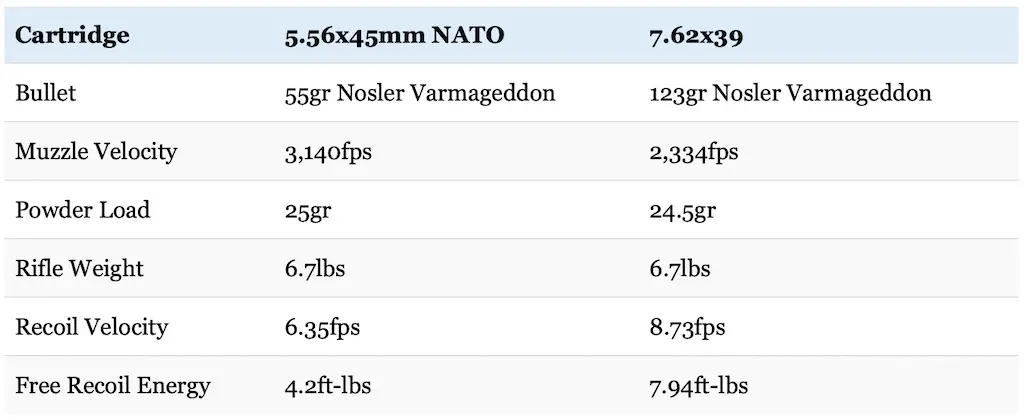
Felt recoil will vary from shooter to shooter and rifle to rifle, but free recoil energy is still a useful way to compare cartridges.
The advantage the 5.56x45mm NATO has over the 7.62x39mm in terms of a flatter trajectory and less wind drift stems from the fact that the 5.56 NATO shoots considerably smaller and lighter bullets at a higher velocity.
For instance, the vast majority of 5.56x45mm factory loads shoot bullets in the 55-77 grain range. Of these, 55 grain, 62 grain bullet weights are the most common. On the other hand, the larger diameter 7.62x39mm uses factory loads with Not only are these bullets heavier than the most common bullets used by the 5.56x45mm, but they also have a slightly higher sectional density (SD).
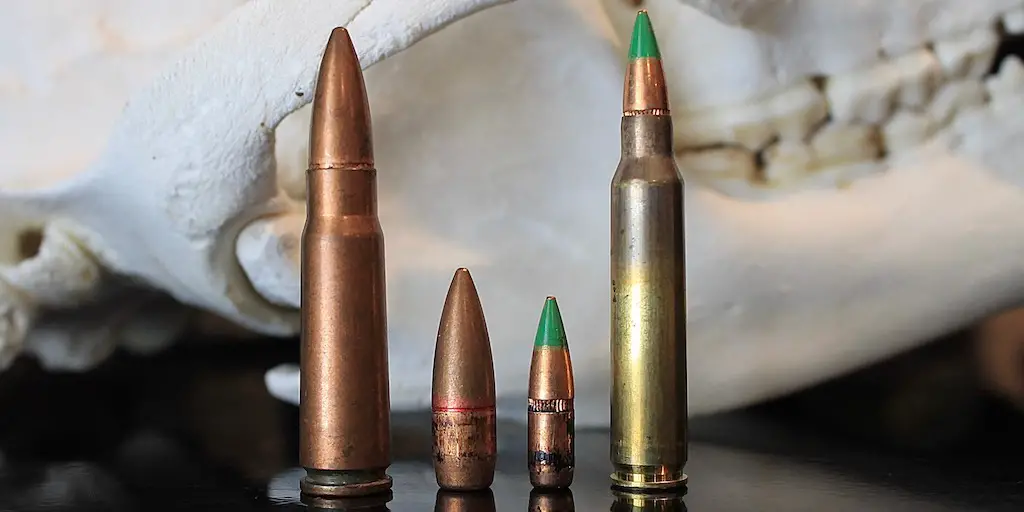
Sectional density (SD) is a measure of the ratio of the diameter of a projectile to its mass. All other things equal, a heavier projectile of a given caliber will be longer and therefore have a higher sectional density and consequently penetrate deeper than projectiles with a lower mass and sectional density.
For instance, 55gr and 62gr .224″ bullets have sectional densities of .157 and .177 respectively. However, a 123gr .311″ bullet has a sectional density of .183, which compares favorably to the most common .224″ bullets.
The 7.62×39 also uses larger diameter bullets and consequently has almost twice as much frontal surface area (also known as cross sectional area) than the 5.56x45mm NATO (.07592 vs .03938 square inches). All other things being equal, a bigger bullet will make a bigger hole, cause more tissue damage, and result in more blood loss.
While the 5.56x45mm NATO has a distinguished history of use in the hands of military and police snipers, designated marksmen, and competition shooters, the 7.62×39 has gotten a bad reputation for accuracy over the years. This is probably due to the fact that most people shooting the cartridge are using cheap military surplus ammo.
In fact, a good SKS or AK is capable of surprising accuracy when using quality ammunition.
The Finnish RK 62 so called “Valmet” rifle (which is a Finnish AK derivative) a great example of a shockingly accurate rifle in 7.62×39 with the right ammo.
However, the 7.62×39 is still usually at a pretty significant disadvantage in terms of accuracy when compared to the 5.56x45mm NATO.
So where do we stand overall with both cartridges?
With a flatter trajectory and less wind drift, the 5.56x45mm NATO does have a pretty big advantage over the 7.62x39mm in external ballistics. This makes the cartridge more forgiving of range or wind estimation errors than the 7.62×39. It’s also a more accurate cartridge with less recoil than the 7.62x39mm, both of which help maximize the shooting abilities of the person behind the gun.
On the other hand, the 7.62x39mm has a big advantage in frontal surface area to go along with smaller advantages in sectional density and kinetic energy.
It’s a big oversimplification to be sure, but in short, due to the advantages of the cartridge in terms of accuracy, recoil, and trajectory, it’s generally much easier to hit a target with the 5.56 NATO. However, the 7.62×39 hits harder and causes more tissue damage.
While both cartridges are quite capable on many species of big game at short range, neither cartridge is realistically suitable for hunting out past 200 yards (or 300 yards for varmints with the 5.56×45).
Most 7.62×39 rifles and ammunition aren’t accurate enough for accurate shot placement out past that range, plus the arching trajectory of the cartridge is not forgiving of range estimation errors. While it’s much easier to hit targets with the 5.56x45mm, those light bullets do not retain energy very well and simply lack the power to reliably and cleanly take big game at longer range.
5.56 vs 7.62x39mm: Ammunition Selection
The .223 Remington/5.56x45mm NATO and 7.62x39mm are extremely popular and consistently rank in the top 10 best selling rifle cartridges in the USA each year and there are tons of ammo choices for each.
Or at least, that was all true until pretty recently.
Traditionally, copper washed FMJ bullets with a steel case produced by Brown Bear, Silver Bear, Tula, or Wolf are by far the most common choices for 7.62x39mm ammo out there. This is steel cased ammo that fires bullets with a steel jacket and/or steel core, so they’re not allowed at many shooting ranges. However, those same companies (plus others like Federal and Hornady) do make soft point or hollow point 7.62×39 hunting ammunition as well.
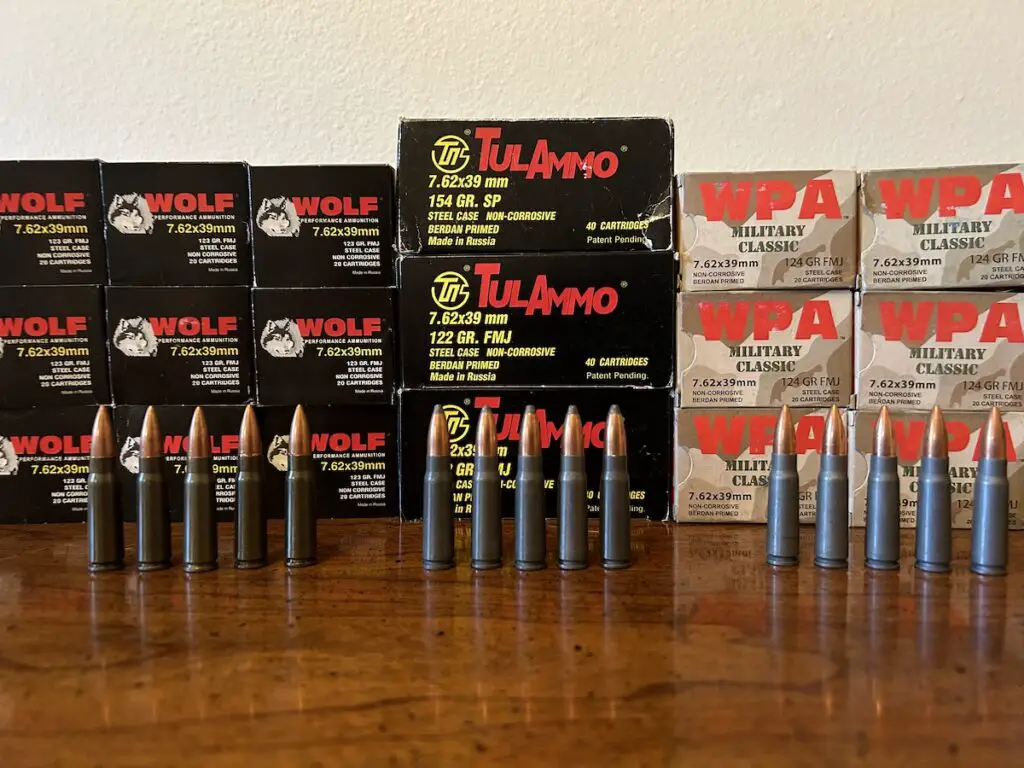
The problem is that ammo is harder to find now in the USA in 2024 than used to be the case. This is due to sanctions placed on Russia after the 2022 invasion of Ukraine. This didn’t completely and instantly stop the importation of that ammo (and those sanctions are for all Russian produced small arms ammo, not just 7.62×39), but this did mean no import licenses have been renewed when they expired.
As far as I know, there’s no new Russian produced 7.62×39 ammo getting into the country now and I don’t expect that to change as long as this war continues.
That stuff hasn’t completely disappeared from the market as of July 2024, but it’s not as easy to find or as inexpensive as it used to be.
One last note regarding 7.62x39mm ammunition: a lot of the military surplus 7.62x39mm ammo, like the M67 Yugoslavian and almost any surplus Chinese ammo, is corrosive. This ammunition is often very reasonably priced and will function well, but you should be very diligent about cleaning your rifle immediately after shooting corrosive ammo.
Fortunately, American ammo makers do produce 7.62×39 ammo, both for hunting and for general shooting at the range.
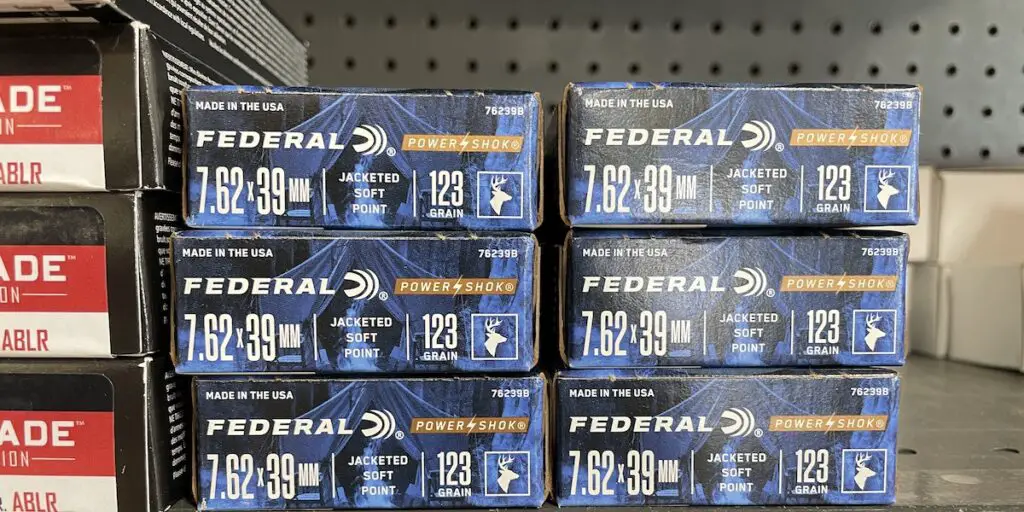
For instance, Horandy offers the 7.62×39 in their Black line with 123gr SST, Federal offers it in their Power Shok line with a 123gr SP, Remington offers the cartridge in their Core Lokt line with 125gr PSP, and Winchester has the cartridge in their Power Point and Deer Season XP lines, both with 123gr bullets.
All those loads have very similar ballistics and fire a ~123gr bullet at around 2,350fps.
What about the 223 Remington and 5.56 NATO?
Remember: a rifle with a 5.56 NATO chamber can usually safely and accurately fire .223 Remington ammunition, but the reverse is not always true.
When the fact that most 5.56x45mm NATO rifles can use .223 Remington without any trouble is taken into account, there is clearly a much wider variety of ammunition available for rifles chambered in 5.56 NATO.
This ammo ranges from match grade and surplus FMJ ammo best suited to work at the range on one end of the spectrum, to hollow point, soft point, and ballistic tip ammo designed for hunting and personal protection on the other end.
Note that FMJ ammo is generally NOT legal for hunting in most states. So, while that military surplus 5.56x45mm and7.62x39mm ammo is good for use at the range, I don’t recommend taking it afield in search of game.
Fortunately, pretty much every ammunition manufacturer of note produces a wide variety of ammo for the .223 and/or 5.56 NATO.
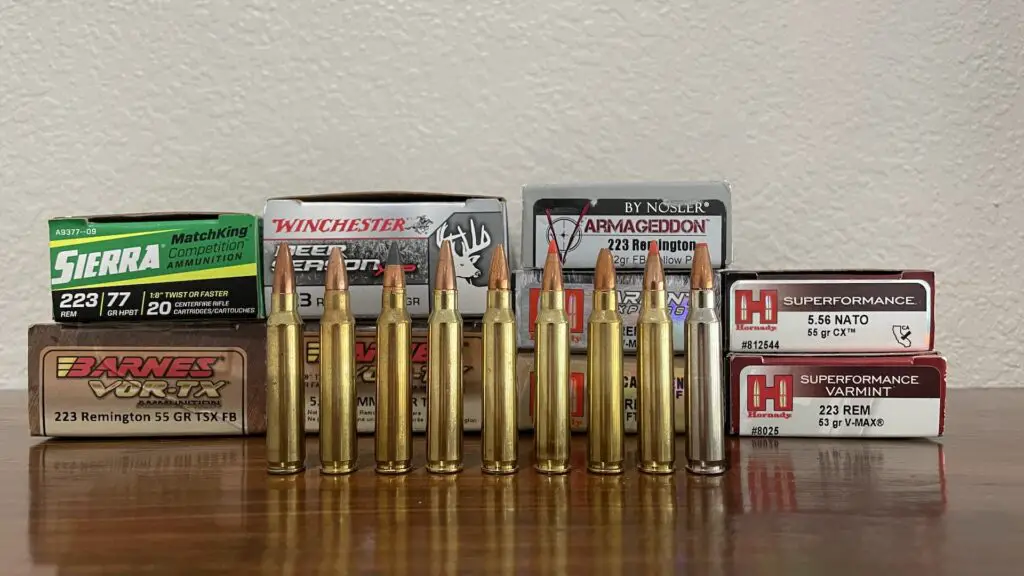
This is an especially popular varmint round, so virtually every major style of varmint bullet is available in these cartridges: the Barnes Varmint Grenade, the Berger Varmint HP, the Hornady NTX and V-Max, the Nosler Ballistic Tip and Varmageddon, the Remington AccuTip V, and the Speer TNT (just to name a few).
The SAAMI spec twist rate for the 223 Remington is 1:12”. However, it’s not unusual to find rifles in 223 or especially 5.56 NATO with a faster 1:9, 1:8, or 1:7 twist rate that can use longer, higher BC bullets.
To that end, the 223 Remington (or 5.56x45mm NATO) is available with projectiles like the 55gr, 62gr, and 70gr TSX from Barnes, the 62gr Fusion and 64gr Power Shok soft points from Federal, the 50gr and 55gr CX, the 73gr FTX, and the 75gr InterLock from Hornady, the 70gr AccuBond from Nosler, and the 77gr Tipped MatchKing from Sierra.
Add it all up and you have an incredible variety of ammo for the 223 and 5.56.
In fact, there’s much more variety for those rounds than is the case for the 7.62×39. The same is also true with ammo availability in general. They details do vary depending on the specific ammo you’re talking aobut, but 223 and 5.56 ammo are usually less expensive as well.
BUY SOME QUALITY 223 REMINGTON AMMO HERE
BUY SOME GREAT 5.56x45mm AMMO HERE
BUY SOME EXCELLENT 7.62x39mm AMMO HERE
If you’d like to learn more about some of the various hunting ammunition choices for the 223 Remington and 7.62×39, read these articles:
Best 223 Ammo For Hunting Deer, Hogs, And Other Big Game
Best 7.62×39 Ammo For Hunting Deer & Other Big Game
Though it’s certainly possible to reload for the 7.62×39, components for the .223 Remington/5.56 NATO are much more common. Additionally, be careful about trying to reload 7.62x39mm brass: most of the stuff out there is Berdan primed, which will require different equipment from the Boxer primed brass most American cartridges use.
Finally, while there are tons of good quality .224 caliber bullets to choose from for the .223 Remington/5.56x45mm NATO, .310 and .311 hunting bullets for the 7.62×39 aren’t nearly as common (though they’re out there).
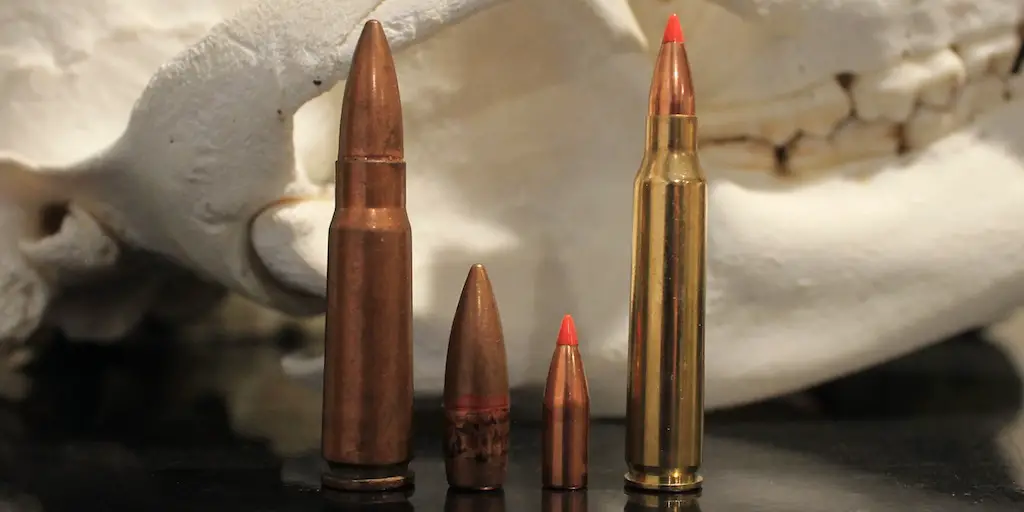
5.56 vs 7.62x39mm: Rifle Selection
Probably due to the military roots of the cartridges, the 5.56x45mm NATO and 7.62x39mm are most commonly chambered in semi-automatic rifles.
In particular, AR platforms like those made by Bushmaster, CMMG, Noveske, Smith & Wesson, Sig Sauer, and Wilson Combat, are extremely popular with the 5.56 NATO. On the other hand, the 7.62×39 is available in a number of AK clones
There are a few AR-15 variants chambered in 7.62×39, but it’s not nearly as common. This is because the extreme taper of the cartridge necessitates the use of special magazines and the larger rim diameter of the cartridge requires a new bolt, bolt carrier, firing pin, etc.
Those 7.62x39mm magazines are also much more heavily tapered and have a more distinctive “banana” shape than typical 5.56 magazines.
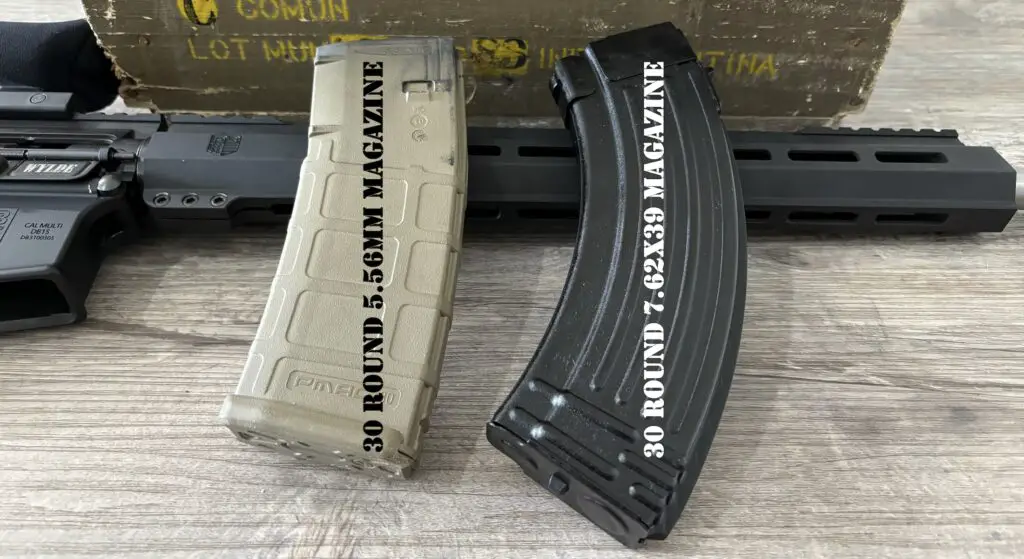
Both cartridges are available in the lightweight CZ 527 (which is now out of production) as well as the Ruger American Ranch bolt-action rifle, the Howa Mini bolt-action rifle (223 Remington and 7.62×39), and the semi-automatic Ruger Mini-14/Mini-Thirty rifles (5.56 NATO and 7.62×39).
BUY A DEPENDABLE 5.56x45mm RIFLE HERE
BUY A QUALITY 7.62x39mm RIFLE HERE
5.56/223 vs 7.62×39: Which Is Right For You?
Roughly comparable to the .30-30 Winchester in terms of power, the 7.62x39mm is well suited for hunting medium sized game at short to medium range. Basically, if you consider the .30-30 Winchester adequate for the job, then the 7.62×39 should also do just fine in the same situation.
While it’s absolutely capable of cleanly taking big game, the .223 Remington/5.56 NATO is really just a borderline big game hunting round. For that reason, the cartridge isn’t legal for deer hunting in many states.
That being said, the advent of better quality bullets in recent years has made the .223 Remington and 5.56x45mm more effective big game hunting than they used to be. Since it is commonly available in semi-automatic rifles and has such a light recoil, follow-up shots are very easy with the 5.56.
This makes the cartridge very popular for hunting situations that require a lot of shooting, like feral hog control. When using a quality bullet like the Hornady GMX or InterLock, the 5.56mm NATO will really do a number on all but the biggest hogs.
If we’re really being honest with ourselves, the 5.56 NATO and 7.62x39mm are best suited for radically different tasks: the 5.56 NATO for varmint and pest control and the 7.62×39 for big game hunting.
The flat trajectory and lightly constructed bullets most common with the 5.56x45mm make it great for taking shots at small, thin skinned animals like prairie dogs, coyotes, foxes, and bobcats.
On the other hand, the 7.62x39mm has an advantage when hunting larger game like deer, feral hogs, and black bear because it shoots heavier and larger diameter bullets.
Are you looking for a cartridge with good prospects for widely available and inexpensive ammo for target shooting? Though they’re roughly comparable in terms of availability and price of ammo, the 7.62×39 has a slight edge here. However, the 5.56 NATO is the better choice for precision shooting.
Are you looking for an ideal cartridge to use in an AR-15 platform? Both are available in AR style rifles, but the 5.56 NATO has a big advantage here because it was originally designed for use in the M16/M4. By the same token, if you really like AK style rifles, then the 7.62×39 is the obvious choice.
Are you very sensitive to recoil? Both have very mild recoil, but the 5.56 NATO round kicks a lot less than the 7.62×39.
Do you want a cartridge suitable for self or home defense, potentially in a SHTF scenario? Both cartridges will certainly work in this regard, but IMO, the 5.56x45mm NATO has the edge here. Not only are there a larger number of high quality, purpose built self-defense ammo with very good terminal ballistics to choose from for the 5.56 NATO, but the cartridge also has a very mild recoil that facilitates follow-up shots.
Do you primarily hunt medium sized game like deer, feral hogs, or black bear at ranges within 200 yards? Both are good rounds that will absolutely get the job done if you do your part, but the 7.62×39 is generally a better choice. Neither cartridge is an effective round for long range hunting though, so don’t be tempted to take shots on big game animals outside 200 yards with them.
Are you looking for a cartridge to hunt predators and small game animals with? The 5.56 is the better choice here because it has a flatter trajectory and there are more types of purpose built predator and varmint hunting 5.56 NATO ammo choices.
As I’ve stated before: the 5.56x45mm NATO and 7.62x39mm are both very good rifle cartridges. However, since the difference between them (5.56 vs 7.62×39) is pretty big in certain respects, each cartridge is better suited to specific situations than the other.
For a more detailed discussion on how the .223 Remington compares to some other popular high velocity cartridges, read the articles below:
22-250 vs 223 vs 204 Ruger vs 220 Swift: Clash Of The Speed Demons
224 Valkyrie: Should You Buy One?
Enjoy this article about the 223/5.56 vs 7.62x39mm debate? Please share it with your friends on Facebook and Twitter.
Nosler provided the data used to compare the case capacity of the cartridges (here and here). The Lyman 50th Edition (p139-143 & p270-271), and Hornady 10th Edition (p160-178 & p618-621) reloading manuals were also used as references for the history of the cartridges and provided data to compare their size and recoil. Ballistic data for original 5.56x45mm and 7.62x39mm military cartridges were obtained from Inetres and Ballistic Studies. The data used to compare the trajectory of the cartridges was obtained from Barnes and Hornady (here and here). Maximum pressure obtained from SAAMI (p24 and p26). I used the Hornady Ballistic calculator and Shooters Calculator to compare wind drift, the range each bullet goes subsonic, and recoil for the cartridges.
Make sure you subscribe to The Big Game Hunting Podcast and follow The Big Game Hunting Blog on Facebook, Instagram, Twitter, and YouTube.
NEXT: 223/5.56 vs 300 BLACKOUT vs 308 WINCHESTER: WHICH IS BEST?
John McAdams is a proficient blogger, experienced shooter, and long time hunter who has pursued big game in 8 different countries on 3 separate continents. John graduated from the United States Military Academy at West Point and is a veteran of combat tours with the US Army in Iraq & Afghanistan. In addition to founding and writing for The Big Game Hunting Blog, John has written for outdoor publications like Bear Hunting Magazine, The Texas State Rifle Association newsletter, Texas Wildlife Magazine, & Wide Open Spaces. Learn more about John here, read some of John’s most popular articles, and be sure to subscribe to his show: the Big Game Hunting Podcast.


Great article. Covers all the bases. Nice pointers for buying rifles and bullets. Personally I’m a fan of the 7.62 x 39.
Thanks Paul! Glad you enjoyed it! I agree that the 7.62×39 is a great cartridge. What loads do you prefer for it and what all have hunted with it?
John
This was an informative and easy-to-read article. I appreciate your neutrally-toned writing style, use of data, and integration of links to other articles of interest.
Well done 😇
Thanks!
I really like how detailed the comparison is. The article tells me all I need to know to make a choice and it is also easy and addictive to read.
This was my favorite article that details the difference between the 7.62 vs. 5.56. Thank you for giving stats and facts and also exploring the different scenarios that each gun would be utilized in and the effectiveness they each provide.